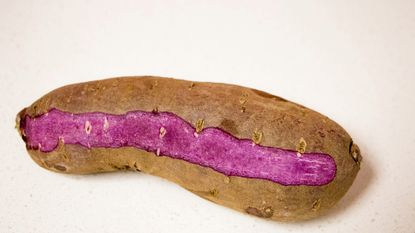Growing Okinawan Purple Sweet Potatoes


When you think sweet potatoes, chances are you think of those orange fleshed things at Thanksgiving, maybe with marshmallows on top. While there's nothing wrong with those, they're far from the only sweet potatoes out there. Keep reading to broaden your sweet potato horizons.
History of Okinawan Purple Sweet Potato Plants
Okinawan sweet potato history is a funny one. Even though it gets its name from a prefecture in Japan where it's extremely popular, it's actually native to the Americas. It was picked up by European explorers sometime between 1492 and 1605 and carried to Asia. It especially took hold in Japan, and from there it travelled to Hawaii. To this day it's an important staple in both places. Okinawan sweet potatoes are also sometimes called Okinawan yams. This is due to a long history of confusion and conflicting opinions about what constitutes a yam or a sweet potato. We don't need to get into that here - all you need to know is that both names deal with the same potato. The potato in question has a pretty bland light brown skin, but the meat inside is a beautiful vivid purple sometimes streaked with white. The flavor is sweet and pleasant, and the texture is creamy. It's very rich in vitamins and has been called a superfood. It maintains its purple color very well through the cooking process.
Growing Okinawan Purple Sweet Potatoes
Growing an Okinawan sweet potato vine is rewarding as long as you have the right climate. It can be grown like other sweet potatoes and needs a long, hot growing season. Plants tend to come as live cuttings that are transplanted directly into the ground. Plant your cutting in a hill of rich soil. As it grows, add more soil to the hill - this will give the plant extra room to grow underground and protect it from weevils. You can usually harvest Okinawan sweet potatoes after 120 to 180 days.
Gardening tips, videos, info and more delivered right to your inbox!
Sign up for the Gardening Know How newsletter today and receive a free download of our most popular eBook "How to Grow Delicious Tomatoes."

The only child of a horticulturist and an English teacher, Liz Baessler was destined to become a gardening editor. She has been with Gardening Know how since 2015, and a Senior Editor since 2020. She holds a BA in English from Brandeis University and an MA in English from the University of Geneva, Switzerland. After years of gardening in containers and community garden plots, she finally has a backyard of her own, which she is systematically filling with vegetables and flowers.
-
 How To Get Rid Of Mosquitoes In The Garden: 9 Natural Ways To Make Them Buzz Off!
How To Get Rid Of Mosquitoes In The Garden: 9 Natural Ways To Make Them Buzz Off!How to get rid of mosquitoes is on the minds of people in the summer in almost every region of the world. Learn how to repel the pests without toxic chemicals.
By Mary Ellen Ellis
-
 Monkey Orchid Care: How To Grow This Fascinating Species
Monkey Orchid Care: How To Grow This Fascinating SpeciesThe monkey orchid bears a remarkable resemblance to its namesake and, with a little know-how, can be successfully grown as a houseplant.
By Bonnie L. Grant